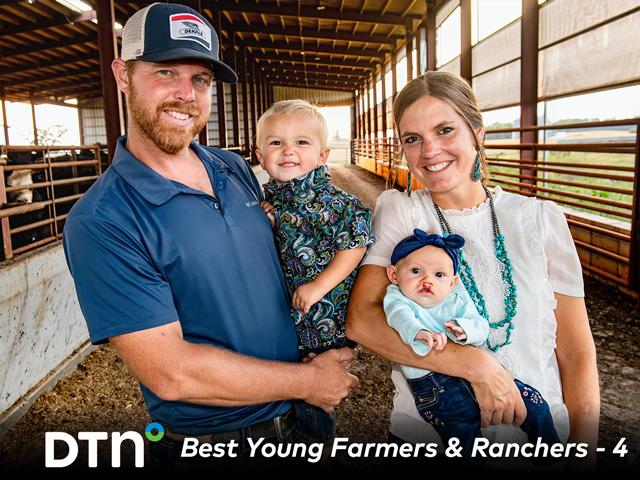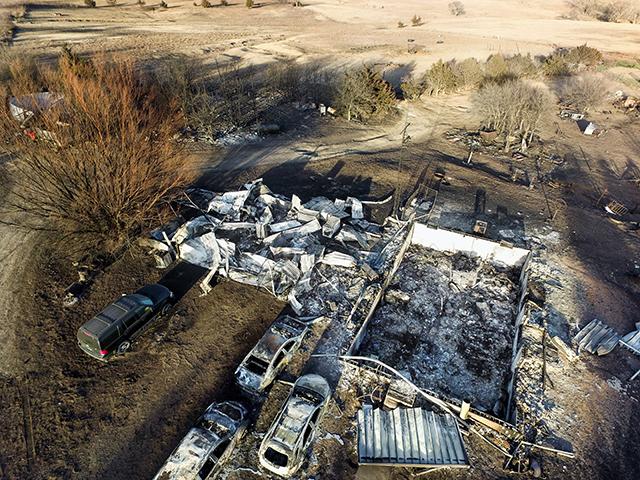Derecho Disaster
Gone With the Wind
It was too late to escape, so Jim Rathbun, 84 years old, didn't run from the fire. He hid from it.
He'd been in his home, just south of Natoma, Kansas, on Dec. 15 when he heard an explosion. He looked out the west windows of his farmhouse and took in a scene almost biblical -- dark clouds of smoke and a wall of advancing fire.
He grabbed his dog, Duke, and hurried out the door and into the farmyard, which was already swirling with flame and soot. It was too late to call for help, too late to drive away. The keys were still inside, anyhow, and there was no going back as flames reached the house.
So, Rathbun flung himself to the dirt and crawled beneath an old broken-down feed truck parked in the yard. He let Duke free to run for fresh air, then curled up and looked out as hell swept across the Kansas prairie, taking along all the family had worked decades to build.
"I set there," he later told his family, "and I watched it all burn."
WINTER WIND
The destruction of the Rathbun ranch was only a small sliver of the devastation wrought that day by a wild and unprecedented storm system that roared across the Midwest, "a serial derecho," according to the National Weather Service, the only derecho on record to have ever struck the United States in December.
The storm, combined with unseasonably warm and dry weather in the weeks leading up to it, turned into a disaster in north-central Kansas, where it was likely snapped power lines or dry lightning that sparked wildfires, largely uncontrollable in the conditions.
Fueled by gusts that roared to nearly 100 mph -- Category 2 hurricane winds -- half a dozen fires devastated more than 400,000 acres, killing two people, destroying cattle herds, eviscerating ranches, burning more than a dozen homes and delivering a crippling punch to a ranching region in the heart of the country.
"Derechos don't happen in December, and when they do, they happen on the Gulf Coast, if anything," DTN Ag Meteorologist John Baranick says. "The conditions you need to get a derecho are hard to come by anyway. The easiest way is to get a lot of heat and a lot of moisture, and you just don't get that in one of the coldest months of the year."
The massive wind caused damage across the Midwest. Much of the worst fire damage was confined to four Kansas counties: Russell, Osborne, Rooks and Ellis. The event was dubbed the "Four County Fire."
"That day, Dec. 15, I'll remember it the rest of my career," Baranick says. "It was one of the most bizarre weather events I've ever seen."
SURROUNDED BY FIRE
Monty Morrill won't ever forget that day, either.
"Toughest day of my life," says Morrill, who runs cattle near Paradise, Kansas, about 10 miles southwest of where Rathbun took shelter under his old truck.
The Morrills have ranched in the area for more than 100 years, but they'd never seen anything like what they endured in December.
P[L1] D[0x0] M[300x250] OOP[F] ADUNIT[] T[]
After hearing reports of fire, Morrill tore down the gravel road toward his ranch in his Dodge pickup until the fire was blown over the road, and the heat and smoke were too intense.
He turned around, but the fire had crossed the road behind him, as well, and had blocked other roads.
He got within a mile and a half of his herd.
"I barely got out," he says.
He finally made it back six hours later. Cows tried to shelter in a draw. Not even half survived.
An exact count of cattle killed by the fires isn't clear, but the Kansas Livestock Association estimates at least hundreds if not more than a thousand.
ASKING FOR HELP
Farmers and ranchers in the region need nearly everything.
"It's just dirt now," Morrill says. "That's it. Just dirt. We'll probably be feeding cattle until at least June or July, depending on how much moisture we get."
Help quickly started to trickle in, but much of it must come from afar. Disaster victims in such tight-knit communities typically lean on neighbors; but this time, the neighbors suffered the same catastrophe.
There's been hay delivered from other parts of the state and some supplies. Some producers sent cattle to friends and acquaintances in other regions, or sometimes even to strangers.
"It really restores your belief in people," Morrill says.
The Kansas Livestock Association began seeking donations right away, and help started arriving before all the fires were even out -- lots of hay but also fenceposts and other equipment.
The organization has turned on its fund-raising arm before to deal with fires, in 2016 and 2017, and pledges 100% of all donations will go to producers to help in rebuilding. Monetary donations can be made online at www.kla.org.
Several collection sites are set up throughout the region, and many of the affected ranchers and farmers, including the Morrills, have GoFundMe pages established to help their operations survive.
"The ag community is so good about taking care of its own. Many people jumped into action, and donations started rolling almost immediately," says Scarlett Hagins, vice president of communications for the Kansas Livestock Association.
The Morrills are thankful for the help, but it can all only do so much.
"You realize you had a lot of stuff you can't replace, windbreaks or even the genetics in the cattle," Morrill says. "Those kinds of things take years and years to build. You have to start over from scratch."
PRAYERS, PLEASE
The broken-down feed truck in the yard at the Rathbun ranch came out singed by fire but not completely burned, and after watching his world turn to ash, Jim Rathbun crawled from beneath it unharmed.
"I'm not joking, it was by God's hand," says his son, Jason, who runs the 150-head ranch. "He said he felt a hand lead him to that truck."
By the time Jason arrived, the house was gone along with miles of fence. Vehicles, barns, hay and tools were no more. Half the herd lay dying.
Nearly everything in the yard, aside from the truck, was rubble.
"You can't even imagine that you work your entire life ... all your goals as a rancher are to keep those animals alive, and then you pop over the hill and see," Jason paused. He cleared his throat but paused again.
An unfathomable amount of work lies ahead.
There are hundreds of miles of fencing that needs replaced in addition to all the facilities required for a modern ranch.
This is just the start.
Jason continues: "You pop over the hill and see a bunch of cows laying there in piles, dead. Rubble. Dead cows. Barren land. A lifetime of work, gone."
There have been glimmers of positivity since. Duke, the only thing Jim Rathbun brought in his desperate flight from the house, found his way to safety and, two days later, to a neighbor's house. There's a newfound appreciation for the life and health of loved ones.
Still, there's one thing the people of the Four County Fire are asking for above all else: "Prayers," Jason says. "We need a lot of prayers."
**
-- Follow Joel on Twitter @JReichPF
[PF_0222]
(c) Copyright 2022 DTN, LLC. All rights reserved.




